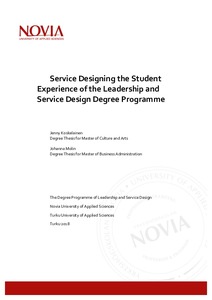Service Designing the Student Experience of the Leadership and Service Design Degree Programme
Molin, Johanna; Koskelainen, Jenny (2018)
Molin, Johanna
Koskelainen, Jenny
Yrkeshögskolan Novia
2018
All rights reserved
Julkaisun pysyvä osoite on
https://urn.fi/URN:NBN:fi:amk-2018101015874
https://urn.fi/URN:NBN:fi:amk-2018101015874
Tiivistelmä
The topic of this master’s thesis is to develop the leadership and service design -programme of Turku University of Applied Sciences and Novia University of Applied Sciences to better meet their students’ and other stakeholders’ needs in the future.
The first aim is to produce a suggestion or a prototype of a pre-introductory package to be delivered before the beginning of the studies. The second aim is to improve the existing study platform to enable a customer-friendly working environment that would increase the information flow and networking possibilities between students, teachers and the industry. The third aim is to intent to find and explain what the connection between the main subjects, leadership and service design is by co-designing the courses with teachers and students.
The methods used to reach these aims are a combination of benchmarking, customer journeys, personas, surveys and interviews. Also, methods of co-design in the form of brainstorming, workshops with students and focus group discussion with both teachers and students were used.
The first aim is to produce a suggestion or a prototype of a pre-introductory package to be delivered before the beginning of the studies. The second aim is to improve the existing study platform to enable a customer-friendly working environment that would increase the information flow and networking possibilities between students, teachers and the industry. The third aim is to intent to find and explain what the connection between the main subjects, leadership and service design is by co-designing the courses with teachers and students.
The methods used to reach these aims are a combination of benchmarking, customer journeys, personas, surveys and interviews. Also, methods of co-design in the form of brainstorming, workshops with students and focus group discussion with both teachers and students were used.
